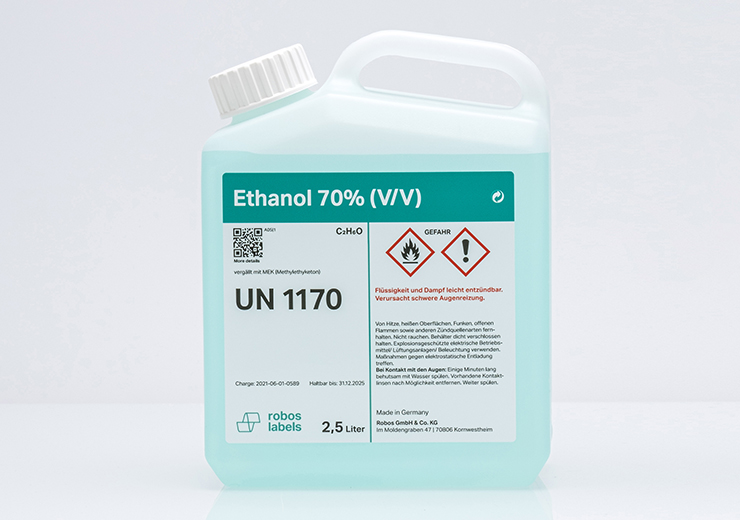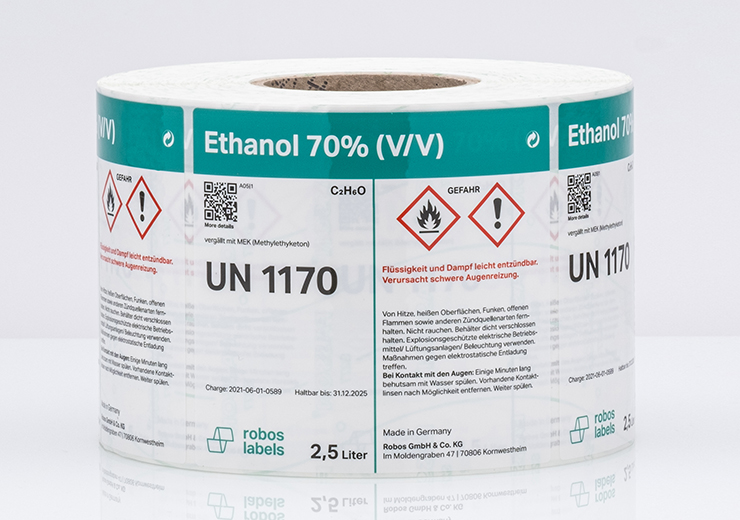Seawater resistant labels for the safe labeling of hazardous substances
These labeling products sustain for the period of three months after the submerging in seawater. The label materials and their imprints have been tested for the adhesion and legibility under these harsh conditions. The test has been set up in cooperation with a brand producer for labeling foils and performed by an UL-laboratory in the USA.
The company robos-labels has a certificate which attests the seawater resistance of the hazmat labels produced and imprinted by Robos-labels in accordance with BS5609 II and BS5609 III.
The main features of seawater resistant labels
- The labels adhere safely and remain legible for at least 3 months
- High dimensional stability, the labels adapt to the container form
- The often very big labels can be also adhered manually
- The labels are very suitable for convex surfaces
- High resistance for outdoor application in all climate zones
- High abrasion resistance with suitable thermal transfer ribbons for the thermal transfer printing
- Suitable for the labeling in conformity with standards like e.g. BS 5609 and GHS
- Very high adhesive power also on difficult substrates
- Optimization of processes due to the automation of material and product flow
- Preprinted labels in individual formats and special forms for the subsequent inscription
Functions and advantages – precisely tailored to your requirements for the labeling
If there is a risk that the hazmat labels will contact seawater or will be exposed to it for a longer period of time, then the certification complying with BS5609 section II is not sufficient. The content of the kegs, canisters and containers swimming in the sea or being washed ashore must be identified fast and secure to minimize the damage to humans and environment.
Only a certificate with attests the durability in accordance with the requirements of BS5609 section III includes the later legibility of the imprint. To exclude the recourse and damage claims in the case of accident the certification of the labels complying to section III is essential.
The seawater resistant labels offer the best possible flexibility and will be adjusted individually to the customer’s requirements. This happens by using suitable special materials of leading manufacturers, individual die-cutting forms and premium adhesives.
The labels can be inscribed directly as required in variable amounts with current data at the site, by that the storage and the management of numerous labels may be dropped.
Some materials and products which must be labeled are still hot when the labels have to be adhered. Other products can have abrasive or dusty or oily surface, which can be labeled with matching adhesives.
Our upscale and accurate processing with most modern die-cutting technologies guarantees the highest precision and reliability for the label application. Thus even seawater labels with adhesives which are difficult to process can be processed mechanically very well, which increases the user efficiency in the long term.
Frequently Asked Questions
Industrial use of seawater resistant labels
The typical labeling products in the scope of seawater resistant labels are hazmat labels (GHS), informational and warning labels, barcode labels, tracking labels, type plates, rating plates. These labels will be applied in the chemical industry (kegs or containers, which contain chemicals or other hazardous substances).
Technical key data of our seawater resistant labels
- Temperature resistance from +80° C (176° F) to -40° C (-40° F)
- UV and weather resistant foils up to 2 years
- High performance materials of polypropylene (PP), polyethylene (PE), polyvinylchloride (PVC), polyethylene high density (PEHD).
- Permanent adhesives with a very good adhesive power for high- and low-energy substrates
- Diverse carrier materials like compressed kraft paper in different thicknesses, transparent plastic liner, kraft paper siliconized on both sides, and environmentally stable kraft paper available
- Subsequently inscribable with thermal transfer printing and inkjet printing method
- Foil materials provide high dimensional stability
Certification of our seawater resistant labels
As a manufacturer robos-labels has a wide range of already approved and certified labeling solutions. When additional customized licenses are required, we can take on the approval- and certification process if desired.
Certification in accordance with British Standard 5609 (BS 5609)
The British Standard 5609 norm is accepted as the most comprehensive test protocol for imprinted labels in the labeling industry. Moreover, the norm sets one of the highest standards for the durability of labels, as generally known. It regulates the specifications and testing methods to determine if the self-adhesive labels coated with adhesive withstand the salty seawater. The norm includes four categories and is divided into two technical sections: section II and section III.
BS 5609, Section II / materials and material combinations
Section II considers the basic material of the self-adhesive labels coated with adhesive – the upper/adhesive combination.
The label material will be stored in seawater for three months to test the label function under these conditions.
BS 5609, Section III/ materials and material combinations and the print durability
Section III considers the finished imprinted, self-adhesive, and labels with adhesive coating.
This applies also to the ink, printing ribbons and the color systems which are used to process the materials certified in compliance with section II. The imprinted labels will be tested for print effectivity, legibility, imprint durability, abrasion resistance and weathering from light, saline water and sand.
Classification of the BS 5609 standard in the international and European administrative directives
As a manufacturer robos-labels has a wide range of already approved and certified labeling solutions. When additional customized licenses are required, we can take on the approval- and certification process if desired.
Certification in accordance with British Standard 5609 (BS 5609)
The British Standard 5609 norm is accepted as the most comprehensive test protocol for imprinted labels in the labeling industry. Moreover, the norm sets one of the highest standards for the durability of labels, as generally known. It regulates the specifications and testing methods to determine if the self-adhesive labels coated with adhesive withstand the salty seawater. The norm includes four categories and is divided into two technical sections: section II and section III.
BS 5609, Section II / materials and material combinations
Section II considers the basic material of the self-adhesive labels coated with adhesive – the upper/adhesive combination.
The label material will be stored in seawater for three months to test the label function under these conditions.
BS 5609, Section III/ materials and material combinations and the print durability
Section III considers the finished imprinted, self-adhesive, and labels with adhesive coating.
This applies also to the ink, printing ribbons and the color systems which are used to process the materials certified in compliance with section II. The imprinted labels will be tested for print effectivity, legibility, imprint durability, abrasion resistance and weathering from light, saline water and sand.
Classification of the BS 5609 standard in the international and European administrative directives
The BS 5609 standard and its roots are to be considered with the regard to two regulations: the “Globally Harmonized System” (GHS) by the United Nations and the “International Maritime Dangerous Goods Code” (IMDG) by the International Maritime Organization.
In accordance with the international implementation of GHS the labels must contain certain universal elements, which show warnings, safety cautions and pictograms. Only this ensures a proper handling of dangerous chemicals worldwide.
The IMGD Code is a global system developed by the International Maritime Organization to regulate the safe transportation of dangerous goods by sea. IMDG also requires that the labels on the dangerous goods must meet certain durability standards to withstand the harsh maritime conditions. IMDG especially demands that the labels must be intact after staying in the seawater for three months. BS5609 tests the material for these requirements and the code sets durability standards for the imprinted, self-adhesive, and labels with adhesive coating, which are used for maritime transportation.
We already meet the following standard with our raw materials:
As a manufacturer robos-labels has a wide range of already approved and certified labeling solutions. When additional customized licenses are required, we can take on the approval- and certification process if desired.
We already meet the following standards and regulations with our raw materials:
- BS 5609 Label resistance to saline sea water
- ADR 2021 Ordinance on the transport of dangerous goods by road, rail and inland waterways (GGVSEB)
- DIN EN ISO 11683:1997-11 Packaging – Tactile warnings of danger – Requirements
- FDA 175.105 INDIRECT FOOD ADDITIVES: ADHESIVES AND COMPONENTS OF COATINGS
- UL969 Marking and labeling systems (labels on smooth and not convex surfaces)
- UL817 Safety cord sets and power supply cords
- UL2238 Cable assemblies and fittings for industrial control and signal distribution
- UL94 Flammability of plastic materials for parts in devices and appliances (UL VTM-0 strictest classification)
- FMVSS 302 Evaluation of the flammability of interior materials (flammability/burn rate)

